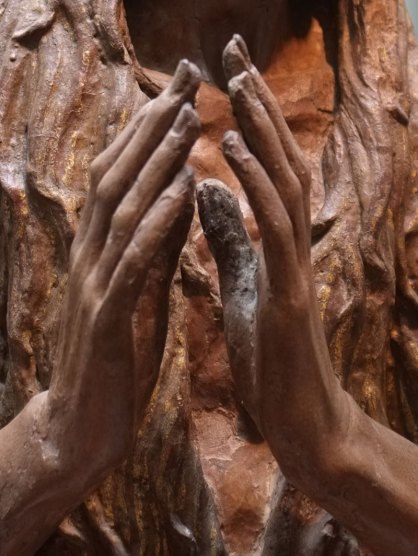Following the trail I started with Titian’s “Pieta”, today I go a few years back to meet another Genius and Master, Donatello.

As I read in PBS’s web site:
“Donatello was not a popular person, but in his sculptures he managed to capture life itself. Every look and gesture was rich in humanity and personality. He was known to mutter “speak, damn you, speak!” at his figures as he worked.
In 1434, following his triumph over the enemies of the Medici, Cosimo requested a special commission from his friend. A statue of an Old Testament hero, symbolizing triumph against the odds. Donatello’s bronze “David” broke all the rules.

A playful, sensuous, and androgynous hero, “David” was the first life-size nude to be cast in bronze since Classical times.
In the 1450s Donatello began work on a terrifying statue, the most vivid of his career. The “Penitent Mary Magdalen”, carved for the baptistry of Florence, is an eloquent vision of fear and decay, perhaps brought on by the realization of Donatello’s own mortality.”
( The material of the previous paragraphs comes from the web site of USA’s Public Broadcasting Service, PBS.)

From David to Mary Magdalen. It is a path of life.
Mary Magdalene has been the subject of many paintings and sculptures.

Titian has painted a portrait of Mary, which is in the Gallery of Palazzo Pitti, a few hundred meters away from Donatello’s sculpture, which is in the Duomo Museum of Florence.
What a contrast between Titian and Donatello’s interpretation! Is it only Titian portraying Mary as a young woman, repentant or not?

Not really. Look at El Greco’s interpretation. Mary is young, very young, beautiful, with long hair that envelopes her body.

The hair is the only common element between Titian’s and El Greco’s paintings and Donatello’s sculpture.

Donatello wanted Mary to be an old woman. A woman approaching the end of her life.

A woman whose face is pierced by the bones, whose eyes inhabit open dark holes, whose mouth is almost toothless.

Her hands are almost forming a prayer pair, but not so. It is as if she was going to pray but she changed her mind as the hands were coming together, but not touching yet.

The aging woman is standing firmly on her feet. As disconcerting her hace and overall condition may be, she is standing with confidence and without any weakness. She is almost “relaxed” when it comes to her feet.
This in my view is the key to “reading” the work. Reading the body.

As the eye travels from the face to the torso, the hands and then to the feet, the ambivalence of the artist manifests itself in a comprehensive way.
This ambivalence is the distinctive feature of the work, a feature that differentiates Donatello’s interpretation from Titian’s and El Greco’s.
In both paintings, Mary is a person wiht a clear attitude and stance in life. Repentant in Titian’s painting, full of devotion in El Greco’s.
But in Donatello’s sculpture, Mary may be skinny and appearing in a state of departure from the worldly affairs, but at the same time she is not fully wholy absorbed by her devotion or repentance. Her body language expresses ambivalence and the coexistence of the worldly stuff with the heavenly. This is what I find amazing in this work. Donatello either consciously or subconsciously is a Modern Master in this work, as he depicts Mary in the state of inner conflict, in the state of Being and Being Not.
What Donatello may have started as a work that would portray his fear of Death, his anguish of getting old, was transformed in the creative process to a work that is full of Life, as Life is ambivalence and contradiction and conflict.



Ενας απο τους μεγαλους δασκαλους (maestri) της γλυπτικης. Πολυ παραξενη η απεικονειση της Μαγδαληνης και τοσο διαφορετικη απ’ το συνηθισμενο κλισε. Κοιταζοντας την νιωθεις αντιφατικα συναισθηματα και σχεδον φρικη. Πολυ δυνατο εργο, αν βρεθειτε στην Φλωρεντια μη παραλειψετε να πατε να το δειτε απο κοντα, ειναι πολυ διαφορετικη η αισθηση απο την φωτογραφια. Πολυ ωραιο το post σου φιλτατε!
Αγαπητη μου παρασκευαστρια (καθοσον εργαστηριακη) και μαγειρισσα, το γλυπτο ειναι συγκλονιστικο, οτ γεγονος δε οτι ειναι απο ξυλο το κανει σχεδον αποκοσμο. Ενω θα περιμενε κανιες το αντιθετο. Ομολογω οτι δεν θα μπορουσα να γραψω κατι για αυτο το συγκλονιστικο εργο αν δεν το ειχα δει απο κοντα. Ολες εξαλλου οι φωτο του εργου ειναι δια χειρος του υπογραφοντος, βοηθουσης και μεγαλης ιαπωνικης εταιριας.
Αν δεν υπήρχε η κώμη, θα έλεγα ότι πρόκειται για το σώμα ενός νεαρού άνδρα, οι γραμμωμένοι μύες, Δελτοειδής(ώμος) και Δικέφαλος βραχιόνος(μπράτσο) τουλάχιστον αυτό μαρτυρούν. Το μυϊκό σύστημα των ανδρών, χάρη στην τεστοστερόνη είναι πιο ανεπτυγμένο από αυτό των γυναικών. Μπορώ επίσης να διακρίνω και το μήλο του Αδάμ, τον προτεταμένο χόνδρο του λάρυγγα που είναι ορατός μόνο στους άνδρες.
Η αμφιθυμία του καλλιτέχνη εκδηλώνεται και ως προς τον προσδιορισμό του φύλου.
Καλή εβδομάδα!
Ενδιαφερον Ρουλα!!!! Θα μπορουσε με βαση τα λεγομενα σου να πει κανεις οτι ο Μαεστρος χρησιμοποιησε εναν αντρα για μοντελο στο εργο αυτο. Της αμφιθυμιας το αναγνωσμα προσχομεν!